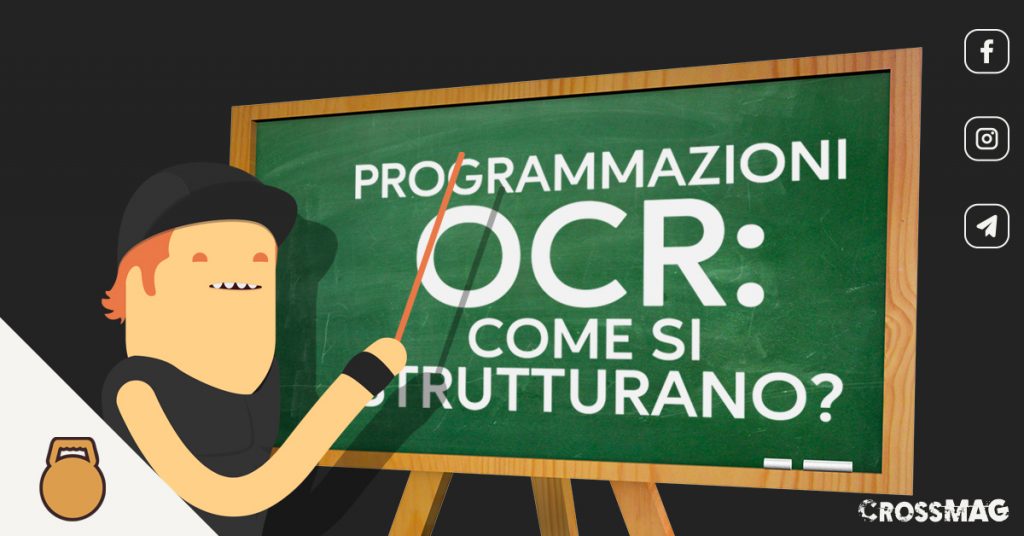OCRs in Italy are a booming business. Several crossfitters and runners will have tried one at least once in their life Spartan Race or a OCR tender of other national circuits.
Even if the fun between mud and water, obstacles and physical fatigue in general are characteristics that many athletes who arrive at OCR competitions have in common, what is still missing in a national, and I dare say even international, panorama is the scientific planning and research aimed at good programming for this type of discipline.
Obstacle course is clearly made of race need obstacles of various kinds both natural and artificial. Being an OCR a hybrid sport, such as CrossFit®, it is complex to program as the variables to be managed are many and different from each other.
An OCR is composed of: running, suspended obstacles (brachiation), lateral or vertical translocation, transport of stable and unstable material such as sandbags, barrels of water, tires, buckets of sand, and more evidence of force, agility, balance and, even in some cases, of memory through alphanumeric codes to keep in mind for a few kilometers and then refer to a marshal in an unknown point of the route.
In short, it's a big mess to program for an OCR athlete!
Index
So where do you start?
Me as OCR preparer, I start from a incoming questionnaire full of questions that include the evaluation of the body composition, anaerobic threshold test e VO2max, lactate if possible, to reach the PB on 5000m, 10000m, half marathon and marathon.
It is also essential to know if the athlete has suffered physical trauma (when and how much). I still ask strength test su deadlift, back squats, shoulder press, if you follow a diet, to get to videos to understand how the subject runs.
The questionnaire is actually much richer in information but these are the main ones.
After analyzing the questionnaire data I try to work on the points of weakness. In the race there are those who have always run at low volume and low intensity, those who instead at high volume and low intensity and those at high intensity and low volume.
Also the joint mobility is critical. How can an athlete who has suffered damage to a shoulder have a good suspension grip if his chain starts from the shoulder, reaching the elbow and finally the hand is deficient? Strength and mobility are two sides of the same coin.
OCR: some basic principles
Another basic principle of my programming is the volume progression and delltraining intensity, be it cardiovascular or through force with overloads.
In addition to this cardinal point there is the principle from simple to complex. A person who has never done a deadlift requires technique and time to improve strength.
In the race instead, an athlete who has never performed athletic gaits will have to work on this side to economize the technical gesture and consequently raise his running rhythm.
I plan weekly with individual and non-group cycles, taking into account the in-season and off-season periods, if the athlete decides to prepare a couple of races in the current year (world and European with related qualifications) or competes several times every month for about 6 uninterrupted months.
How many training days are needed?
A good weekly schedule, for an Elite athlete, should include at least three or four running workouts with different variables.
Quality must be trained through a extensive, intensive varied o short fast, and fractional travel through repeated.
To add the uphill race, or in simulation race through unstable terrain such as earth, mud, use of transport during the race, overcoming walls of various height and shape.
On the other days, functional circuits and submaximal strength exercises will be performed.
Let's not forget that the recovery it is fundamental and is an integral part of proper training planning.
In the final analysis it is important to include everything that represents the in the programming prevention injuries such as ankle sprains or rotator cuff tendinitis.
Therefore proprioceptive exercises and work with elastic bands or small tools will be programmed.
The OCR are stimulants because they allow you to improve in different motor areas enhancing conditional skills and learning new motor patterns.
Let's do it with fun and free space for imagination!
Degree in Motor Sciences and Master's Degree in Sciences of motor education and adapted physical activities
Four-year diploma of Shiatsu operator
Diploma Osteopath DO e MCB massage therapist
Inferno OCR Elite athlete
CrossFit trainer LV2 / Kids
Facebook page: Marco Dalessandro
Instagram: @marco_ocr_elite e @m_dalessandro_osteopata

